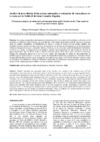Please use this identifier to cite or link to this item:
https://accedacris.ulpgc.es/jspui/handle/10553/106800
| Title: | Análisis de procedencia de las arenas sumergidas y emergidas de cinco playas en la costa sur de Telde (E de Gran Canaria, España) | Other Titles: | Provenance analyses of submerged and emerged sands of five beaches in the Telde southern coast (E of Gran Canaria, Spain) | Authors: | Burgoa Torrontegui, I. Mangas Viñuela, José Sánchez García, María José Quevedo González, L. |
UNESCO Clasification: | 250618 Sedimentología 251090-1 Geología marina. Dinámica sedimentaria |
Keywords: | Playas arenosas Análisis de procedencia Litoclastos Bioclastos Telde, et al |
Issue Date: | 2019 | Publisher: | Consejo Superior de Investigaciones Científicas (CSIC) | Conference: | X Jornadas de Geomorfología litoral | Abstract: | Las arenas submareales, intermareales y supramareales de cinco playas se han estudiado en la costa sur del
municipio de Telde (E de Gran Canaria). Así, se ha llevado a cabo análisis de procedencia de 29 muestras de arena por medio de estudios petrográficos de identificación de granos y contaje de puntos (200 por lámina delgada). Los resultados confirman que hay dos tipos de playas, una con arenas oscuras negruzcas (Salinetas) que es rica en terrígenos volcánicos (fragmentos de rocas y minerales máficos y félsicos), con un porcentaje medio de abundancia de litoclastos 87,4% (σ=5,6), siendo los fragmentos de roca máfica y minerales ferromagnesianos los más abundantes. El resto de playas (Aguadulce, Ojos de Garza, Ámbar y Gando) muestran colores claros cremas pues son ricas en bioclastos marinos con abundancias medias de 37,25% (σ=11,21), siendo más abundantes los granos de flora (fragmentos de rodolitos) que de fauna (moluscos y, en menor proporción, foraminíferos bentónicos, equinodermos y briozoos). No hay homogeneidad de datos entre las arenas sumergidas y emergidas en cada playa, por lo que las dinámicas marina y eólica no son capaces de equilibrar los valores de abundancia. Igualmente, las variaciones encontradas en la naturaleza de las arenas en estas 5 playas pueden ser debidas a factores naturales y antrópicos Subtidal, intertidal and supratidal sands of five beaches were studied in the southern coast of Telde municipality (E of Gran Canaria). Provenance analysis of 29 sand samples was done by the use of petrographic studies and sand grain identification and counting (200 in each thin section). The results confirm that there are two type of beaches, ones with blackish sands (Salinetas) and rich in volcanic terrigenous (mafic and felsic rock fragments and minerals) with a mean abundance of 87.4% (σ=5.6) in lithoclasts, being mafic rock fragments and ferromagnesian minerals the most abundant. All the other beaches (Aguadulce, Ojos de Garza, £mbar and Gando) show light cream color as they are rich in marine bioclasts with mean abundances of 37.25% (σ=11.21), being flora (rodolith fragments) grains more abundant than fauna (mollusks and, in a minor proportion, benthic foraminifera, echinoderms and bryozoan). There is not homogeneity of data between submerged and emerged sands of any of the beaches, so marine and aeolian dynamics are not capable of equilibrate abundance values. In addition, the variations found in the nature of the sands of these 5 beaches are because of natural and anthropic factors. and sand grain identification and counting (200 in each thin section). The results confirm that there are two type of beaches, ones with blackish sands (Salinetas) and rich in volcanic terrigenous (mafic and felsic rock fragments and minerals) with a mean abundance of 87.4% (σ=5.6) in lithoclasts, being mafic rock fragments and ferromagnesian minerals the most abundant. All the other beaches (Aguadulce, Ojos de Garza, £mbar and Gando) show light cream color as they are rich in marine bioclasts with mean abundances of 37.25% (σ=11.21), being flora (rodolith fragments) grains more abundant than fauna (mollusks and, in a minor proportion, benthic foraminifera, echinoderms and bryozoan). There is not homogeneity of data between submerged and emerged sands of any of the beaches, so marine and aeolian dynamics are not capable of equilibrate abundance values. In addition, the variations found in the nature of the sands of these 5 beaches are because of natural and anthropic factors. |
URI: | https://accedacris.ulpgc.es/handle/10553/106800 | ISBN: | 978-84-09-12002-4 | Source: | X Jornadas de Geomorfología Litoral. Libro de ponencias / Durán, R., Guillén, J., Simarro, G. (eds), p. 169-172 |
| Appears in Collections: | Actas de congresos |
Page view(s)
142
checked on Aug 17, 2024
Download(s)
150
checked on Aug 17, 2024
Google ScholarTM
Check
Altmetric
Share
Export metadata
Items in accedaCRIS are protected by copyright, with all rights reserved, unless otherwise indicated.
